A few days ago, we released our review of the Intel SSD DC P3700 NVMe SSD. This new entry to the enterprise market brought in just under 500K IOPS in a single PCB and single controller design package, a design not needing the traditional RAID solution to achieve performance above 2.5GB/s. As much attention as it gained from the enterprise community, we were literally swamped with e-mails requesting common enthusiast benchmarks, along with the question of the day, “Will it boot?” As much as the DC P3700 is built as an enterprise storage solution, interest definitely carries much further as we anticipate release of the entire P3000 NVMe SSD family in the near future.
WHAT IS NVME?
Let’s start with a brief understanding of NVMe (Non-Volatile Memory Express) that enables us to understand why this protocol is much faster with a much lower latency than SATA or SAS. First, NVMe has a minimal command set in comparison and consists of only 10 administrative and 3 I/O commands. Avoiding a very confusing explanation, consider it this way. We have two ladders that are the same distance to the top, except the ladder on the right has twice as many rungs. Each person is required to come in contact with each rung on their way to the top. Who do we think would get their first? Of course, the person scaling the ladder with fewer rungs would arrive first, but another inevitable result that we might not consider, is the increased probability for error from the person on the right. The other given of NVMe is that, by connecting directly to the PCIe lanes, it is closer to the CPU and results in a much lower latency. SATA was built for mechanical hard drives; NVMe is built for flash.
BUT WILL IT BOOT?
The P3000 NVMe family will boot, but only with Windows 8.1, or enterprise versions of Windows and Linux. This is not good news for those of us who swore that Win8 would never be seen in our systems. The NVMe driver is native to Windows 8.1 which is key to its installation. Installation can be accomplished with Windows 7 and use of the included NVMe driver, but there is no possibility of using it as a boot drive. Even in Windows 8.1, there is a trick to the installation and the key term to remember is ‘UEFI‘. In our trial and error learning of the ONLY way to install the P3700 on a typical board, we discovered that one first had to install Windows 8.1 onto the P3700 within the optional Windows UEFI shell.
This is the only way the P3700 will be recognized as a bootable device. After Windows 8.1 is installed onto the P3700 and the system reboots, it is necessary to go into the BIOS immediately and enable the ‘Boot From UEFI Only’ option, save and reboot into the BIOS once again. From there, the drive was selected as a boot device known as ‘Boot Manager’ and all went smoothly. As a final step, install the latest Intel NVMe driver as it is much higher performing than that native in Windows 8.1.
SPECIFICATIONS
This Intel chart describes the complete specifications for all three P3000 drives very well, and the key takeaways are performance, endurance and warranty. Pricing is also unexpected as we believe that many would have, and may still, grab the P3700 AT $1200, but the P3500 is destined to be in great demand on release.
Not mentioned in the chart but worth noting is the fact that the Intel P3000 family is fully TRIM compliant and capable of garbage collection.
INTEL SSD DC P3700 BUILD AND COMPONENTS
The Intel P3700 consists of a single PCB design that is covered by a very cleverly shaped aluminum heat sink, held in place by five screws, two of which also secure the end bracket. The NVMe controller has a thermal paste that seats it to the heat sink, while 22 chips contain thermal pads to further dissipate heat.
Perhaps one of the most valuable contributions to this SSD comes from the PCIe Gen 3 X4 interface at the base of the PCB. Prior, we had seen PCIe SSDs using the Gen 2 interface, which meant that they were capable of a theoretical maximum of 500MB/s (5GT/s) per lane, or 2GB/s for a x4 device. Gen 3 is capable of 985MB/s (8GT/s) per lane, for a total of just under 4GB/s. Considering that specs list a high throughput of 2.8GB/s, this could not have been achieved without PCIe Gen 3, at least in a 4 lane design.
On the PCB, we have 36 modules of Intel’s 20nm HET (high endurance)MLC NAND flash memory, five chips of Micron DDR3-1600 DRAM cache memory for a total of 1.25GB, Intel’s 18 channel NVMe controller, numbered CH29AE41AB0, along with two power capacitors that prevent data loss should there be a power failure. Much credit to Intel for this memory that allows the P3700 a maximum of ten drive writes per day and a massive 36.5 PBW (petabytes written) life span.
 The SSD Review The Worlds Dedicated SSD Education and Review Resource |
The SSD Review The Worlds Dedicated SSD Education and Review Resource |

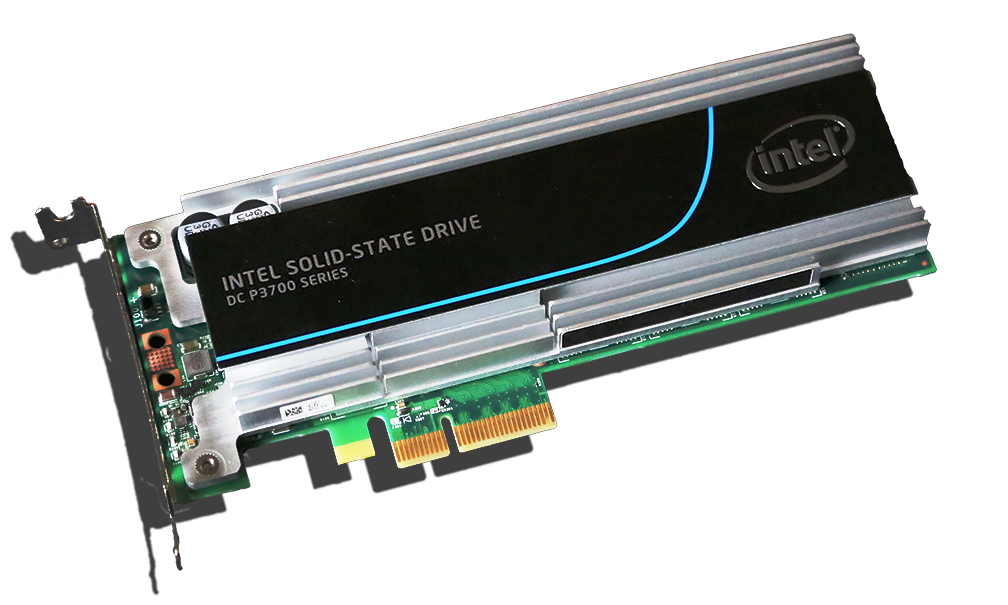
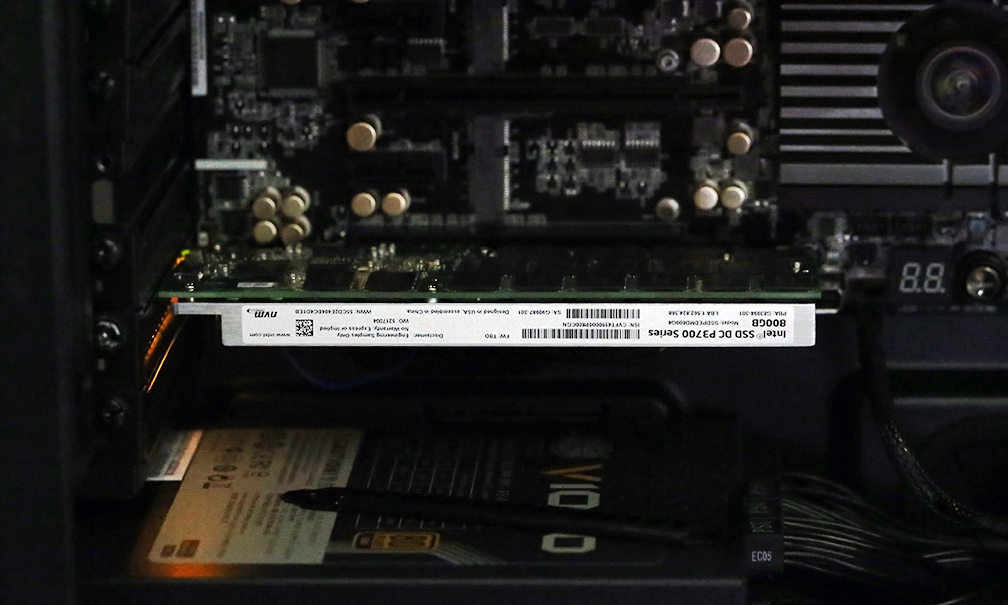
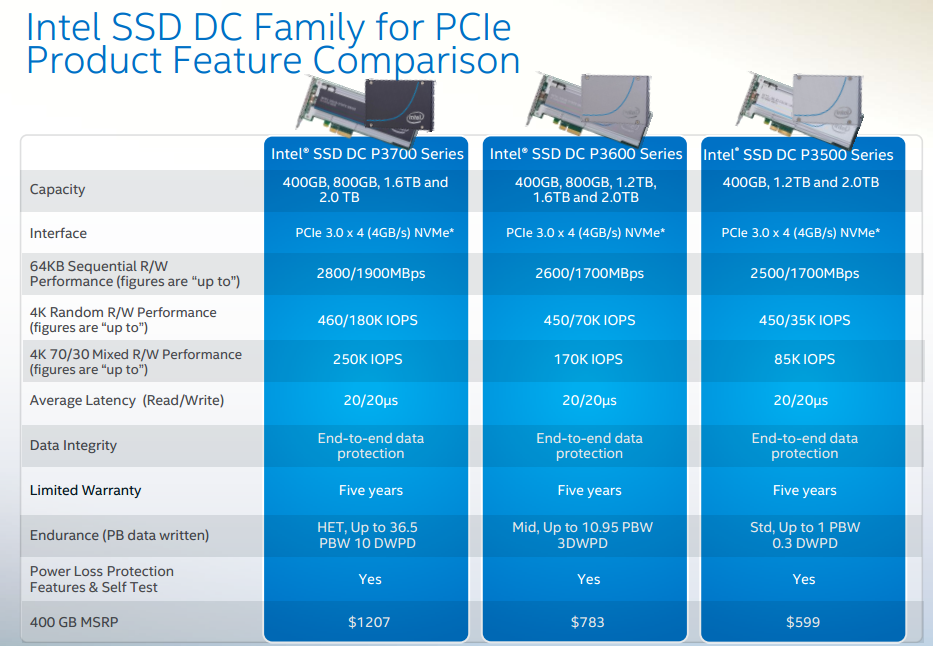
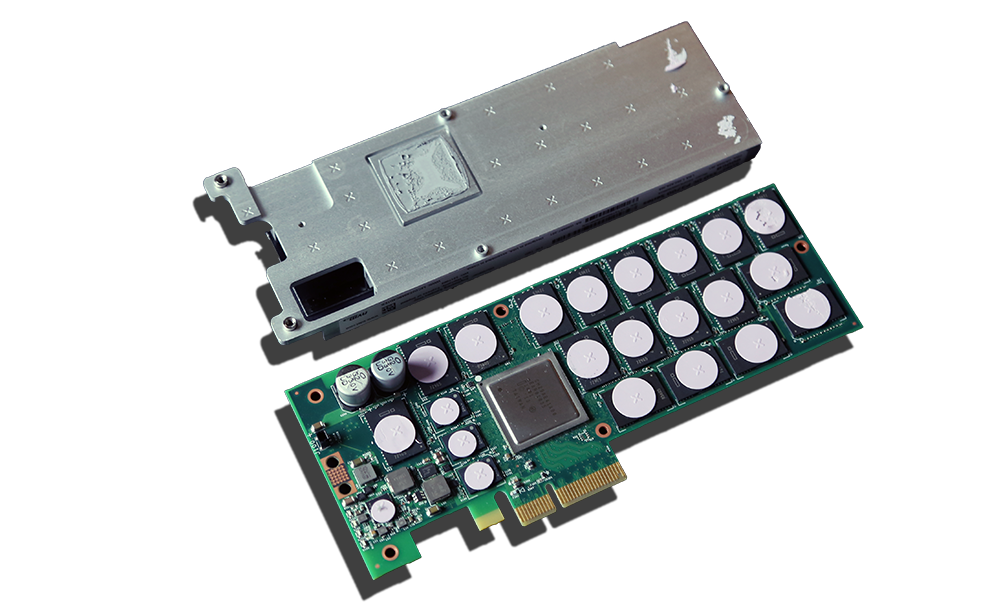
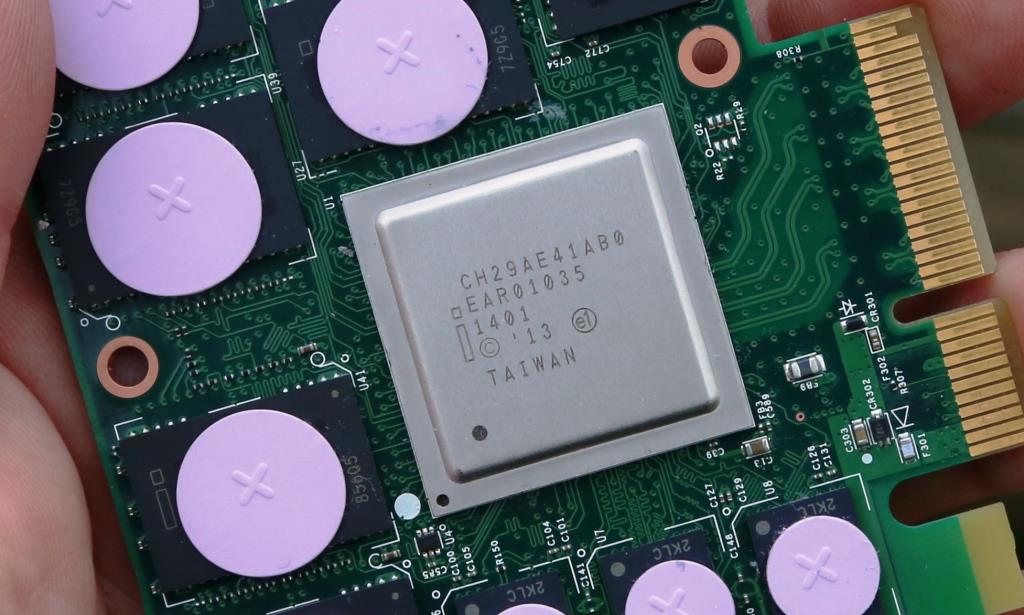
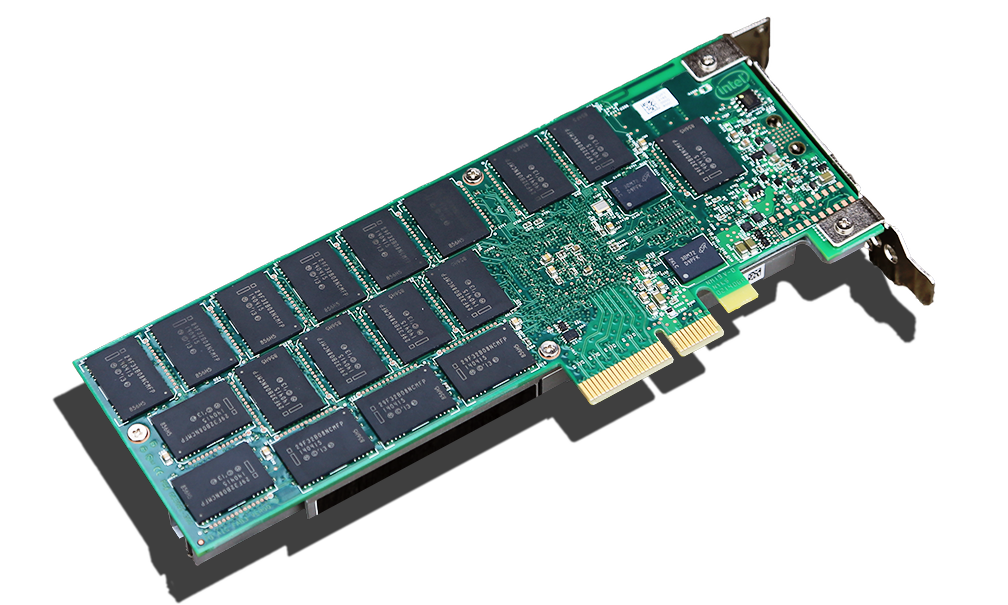
Instead of RAID controllers, won’t there eventually be a need for a flash controller, or flash accelerator card designed to work specifically with these NVMe drives?
Looking at the heat sinking on these units I have to ask if they have thermal shutoffs if things get too hot.
Is all data automatically encrypted when written to NAND on these units?
There is full 256 AES bit encryption. end to end data path protection and and thermal temperature monitoring where throttling will occur if necessary.
Many many thanks for this review! Espacially talking about how to make it bootable and Details like this “…there is no delay and this SSD boots in about 10-12 seconds flat in Windows 8?” make it really outstanding and very usefull for decision for daily-live Power-Workstation based computing 🙂
Thank you for this reply. I will be rebuilding our complete system around Win 8 and this P3700 this weekend. Perhaps I can post some more accurate boot tests and thoughts. Stay tuned.
this would be awesome!!
would be interesting too see how it compares to the samsung m2 941 and the evo 1gb in real life applications, like chrome compilation time, boot time (to be fair from start button press) , big game level load time etc…
it s totally clear that in tnerprise use, this drive is awesome, as it is in benchmarks but it would be fun to see if for enthusiasts it translates into something else than bragging rights…
Hi Les -is there any news about this? I’m very excited 🙂
As in a release date?
Yes in the release date of your further experience with P3700 “Perhaps I can post some more accurate boot tests and thoughts” 🙂
A release date would be great. Any idea when this and/or the P3600 family is going to be available?
The closest I can get to an answer is ‘Fall’ or Q4.
Thanks Les.
I did see after posting the question that Amazon.com now have an expected date of 4th of August. I do hope that is true, I hate it when products are teased so far in advance. Mind you, I’m in the UK so may well have to wait longer anyway.
Hope you used our links and thanks!
This is a really amazing SSD. For the first time in a while it seems like my OCZ Revo 3 x2 has something to upgrade to – at a reasonable price point. I ran a quick test on my daily workstation so everyone can have a reference for exactly how fast this new intel offering is. https://screencast.com/t/q0CSeXKon3 keep in mind this is daily usage on a general purpose workhorse for the last 2 years.
Thanks for the input. Perhaps I should have included similar, but comparison of the 4 and 8KB results merits a definite look. I don’t think we would ever see from a PCIe what we will from the NVMe drive.
Awesome stuff, now where can I get mine?
If I understand this correctly, NVMe is just a protocol, so will I be able to use the p3700 as a win 8.1 boot drive on a Rampage IV black edition mobo?
Yes this should work so long as you can install and then boot from UEFI. WE haven’t tried the board but have had success with a few now…same procedure in all.
Thanks for getting back to me… I am really looking forward to your extended article with more accurate boot times and thoughts
I was hoping to get it done this weekend but decided to hop on the motorcycle with the wife and head 12 hrs down the road to West Virginia… Give me until next week early. Thanks!
Les,
Can we expect to see fire sale pricing from the other PCIe SSD vendors when the Intel units start shipping?
When can we buy these?
Thank you for this and for many other awesome reviews! I might be in the lame minority here, but when it comes along, any reason not to recommend the 3500 in a Thunderbolt 2 PCIe expansion box as a video editing scratch disk for a new Mac Pro?
That is a great idea if you can find just the right TBolt2 external chassis. It is important to understand that the controller in that chassis will have a lot to do with the final speed reached by the intel card, ergo there might be a bit of overkill. Given the right match, however, this might be the most powerful combination available for this external design.
Thanks a lot for the review! I’m considering the DC P3600 800GB PCI-E for my next Workstation, but do you think I will notice the faster speed over, say, a Samsung 850 Pro? My work include photo editing on multiply raw files (fairly big, already compressed files) and using Lightrooms database etc.
I’m fine paying for top class performance, BTW! 🙂
Yes, I believe for extensive media use jumping out of the SATA 3 realm is a definite benefit. In the day to day use, you won’t experience any difference whatsoever, but in media manipulation, it is key.
Thanks for your quick reply, Les. Much appreciated! I had some envy of the very fast SSD in the new Mac Pro, but this certainly looks even more impressive, although the wife won’t like the price one bit! 😉
Yes I understand that all to well right about now eheh.
Is there a full height pci bracket included in the package, so that it can be installed in regular cases?
No, it only come with Half Height bracket, if you install in a normal case, you need to take out the bracket and use electrical tape to fixed it
Just want to make sure this point is clear. UEFI/Win8.1 is required to use these drives as a boot drive, but they can be used as a data drive anywhere the Linux/Windows drivers supports it.
Very very interesting!
I’m currently running an Areca 1882ix (4GB RAM) with 6 x 120GB Sandisk Extremes in RAID0 on my desktop/gaming computer.
Performance of this 800GB version seems great. I’ll have to throw together some benchmarks as a comparison (obviously not apples to apples due to machine differences)…
Does this support Hibernate/Standby functions in Windows 8.1? Just curious, since most workstation/enthusiast users won’t be powered on 24/7.
Has anyone tried these or the 3600 in a RAID config? We have tried 3x 400GB 3600 in a windows RAID stripe and only getting ~2400MB/sec seq read, would have expected to see more
My OCZ Revodrive just took a crap after a year and I decided to purchase the 400GB P3700 as a replacement. It was easy to source locally and in stock for same day pickup (which really surprised me!) It works perfectly with my Asus Rampage Extreme IV – I turned off compatibility mode in the BIOS and switched over the UEFI. I was concerned when the drive didn’t show up in the BIOS at first – but don’t panic. Windows 8.1 setup will find it just fine. Make sure to boot the Windows installation media in UEFI boot mode (or USB drive in my case.) The 400GB model is slightly slower than the 800GB one reviewed, but I am still satisfied. I can post benchmarks if requested.
Forgot to add – thanks @Lee for this awesome review. I wasn’t sure what to purchase after the RevoDrive went out. I do not recommend OCZ products, their support is jerking me around on the warranty and they don’t seem to stand behind their products. I feel safe going with Intel even if it’s a higher priced enterprise product.
Is a Xeon processor required for maximum performance of this SSD? from the product description it specifically says so, I am confused.
Did your test sample come with an optional full height bracket? I’m asking because of your case and the fact, that some pics show the P3700 with a half-height bracket.
It has been awhile but I remember it coming with both. I have an extra in the box and have never purchased one.